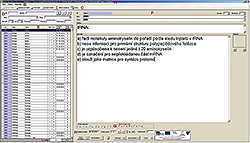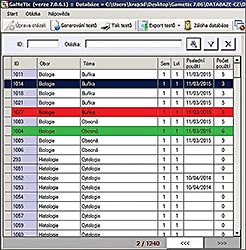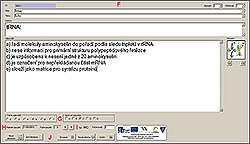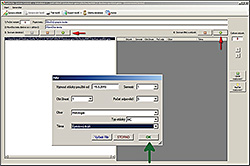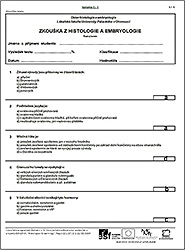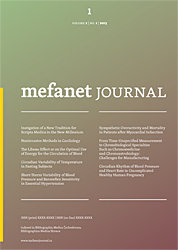
MEFANET Journal 2015; 3(2): 54-60
ORIGINAL ARTICLE
GaMeTix – new software for management of MCQ databases
Dimitrolos Krajčí1*, Pavel Kylar2
1 Department of Histology and Embryology, Faculty of Medicine and Dentistry, Palacký University, Olomouc, Czech Republic
2 Private IT programmer, Křelov, Czech Republic
* Corresponding author: dimikra@gmail.com
Abstract
Article history:
Received 12 May 2015
Revised 26 August 2015
Accepted 23 November 2015
Available online 14 December 2015
Peer review:
Jan Trnka, Martin Vejražka
Download PDF
We have developed new software named GaMeTix for management of large collections of examination questions written in a variety of MCQ (Multiple Choice Question) formats. This application provides a wide scale of functionality modes like collecting and editing sets of questions, generating electronic versions of examination tests, printing examination paper sheets and exporting sets of questions in a plain text document for hard copy archiving or transfer to specific electronic testing applications. The content of the database is searchable according to several criteria using sets of filters that characterize each question. Collections of MC questions can be divided or merged together according to results of the filtering function. Examination questions can be complemented with pictures or diagrams in .jpg format. GaMeTix is a portable, freeware application that runs on MS Windows operating systems.
Keywords
Software; MCQ; database; management; questions; testing; written; electronic
Introduction
Figure 1. An overview of the graphical user interface 1. A – title bar, B – menu bar, C – toolbar, D – search filter bar, E – list of questions window, F – question editing panel, G – number of distractors and correct answers indicators, H – date of the last use of a question and frequency of question usages, I – format of a question and its point value, J – Buttons for selection of a new/another database and questions, K – total number of questions in an open database
Figure 2. List of questions. A row with the currently selected question is highlighted in blue, incomplete questions in red and questions containing the supplementary picture in green colours
Figure 3. Search filter bar with selection criteria
Figure 4. Exporting/Importing dialogue window appears when right clicking on a question in the list an open database
Figure 5. Question editing panel (F) displays question n. 1011. Subject: Biology, topic: Cell, question stem: tRNA, number of distractors: 5, correct answer: C, last used: 11/03/2015, number of usages: 5, format of the question: MC, value of the question: 1 point
Figure 6. Test generator interface GUI contains two panels – list of databases and list of used filters. The databases and filters can be selected with + buttons (red arrows). The filter selection dialogue window shows all selectable criteria (green arrow)
Figure 7. An example of the first page of the printed examination paper. The letter of the alphabet, indicating selection for the correct answer, is to be written into the rectangle located at the right-hand side of each question
Examination of student’s knowledge by application of written or electronic tests is widely used in modern pedagogy [1]. Large collections of examination questions must be managed systematically and securely using dedicated software that allows the user to add new questions progressively and to edit these questions written in various MCQ formats. There is a couple of commercially available software [2–6] for the creation and administration of question banks available to purchase. These applications are costly, proprietary licensed, and must be permanently installed on a computer. Creation of question sheets and their publication for both, printed or electronic delivery is another required feature of such software.
On the other hand, the Learning Management Systems (Moodle [7], Black Board [8], just to name a few) are open source web-based systems designed to run on a university or corporate servers. They provide a wide scale of functionalities, like the construction and delivery of educational courses, development and administration of examination questions and evaluation of individual students and courses. They are inherently bound to internet facilities, complex and rather difficult for a lay person to learn and set up and may require the assistance of IT-trained personnel.
The major requirement of our educators was to have a simple to use, the Czech language localized, secure and portable freeware application to be able to create and manage several databases of MCQs. We have coded and in seven versions practically tested a stand-alone portable application called GaMeTix. It accepts questions in the MCQ (Multiple Choice Single Best Answer Question), MRQ (Multiple Choice Multiple Response Question) and TF (Multiple True/False Question) formats [9,10] and allows for their administration in a fully searchable environment, running either on the PC's system hard drive or on any standard external storage media or flash drives. Examination papers can be exported to .txt, .xls and .pdf files for in-paper examinations or they can be imported into the Articulate Quizmaker 13 software [11] for computer-based (CB) application of assessments. In this report, we analyse specific features of this application and evaluate its functionality in practical testing of Histology for medical students.
Methods
The program has been created under the .NET framework in the C# language. Database of the test questions is stored in a file encrypted using the symmetric cryptography. Questions and generated tests are stored in UTF-8 format and can be imported or exported from/into various formats of documents. The root folder Gametix-CZ 7.4 contains two main folders: The Program folder with all application components in it and the Database-CZ folder with subfolders for databases and exported files. A shortcut to GaMeTix.exe for case-sensitive login into the application is also provided. The folder "Database-CZ" contains subfolders for the main database saved in an internal .gmo file format, secondary databases and all backups. It also contains subfolders for files with exported questions in a plain text format, and a subfolder for generated (not yet printed) tests saved in an internal .gmt file format. Both internal files are .xml files that are encrypted for enhanced security of question databases and created examination tests. Special folders are provided for printable tests in pdf and .xls file formats, for complementary pictures and diagrams, and for saving setups of filters used in previously generated tests. Successful printing of hard copies of examination papers requires the free Microsoft Report Viewer Redistributable Package [12] to be installed on a PC in use. In order to generate tests, one or more databases can be used simultaneously. Access to the program is protected by a username and password. Several user accounts can be created.
Results
The program is composed of five functional units that cover Database Management, Generation of Tests, Test Printing, Test Export and Database Backup. It operates in two graphical user interfaces (GUI). The first GUI is dedicated to the creation and management of databases of questions (Figure 1). The second GUI is used with all other functions. Both interfaces share identical title bar, menu bar and a toolbar.
Database management function
The Database Management window provides the key functions of this software to add new questions to the database and to categorize them by different criteria (ID number, subject, topic, semester, difficulty level, date of the last usage, frequency of use). A new ID number displayed in the first column of the list of questions is added to every new question (Figure 2). A row with the currently selected question is indicated in deep blue colour, incomplete questions are in red colour and questions containing supplementary pictures are labelled in green colour. The serial number of the currently selected question in this list and the total number of questions in the open database is indicated by red numbers at the bottom part of this list (Figure 2).
A collapsible search filter bar is available in this pane to sort and display sets of questions selected according to various criteria (Figure 3).
The entire content of the database or its selected part can be displayed and exported into .txt file (plain text format) or .gmo file (new GaMeTix database) by right clicking on one of the selected questions (Figure 4). Questions can also be imported into the main database from .txt file with proper formatting of questions, or .gmo file (another GaMeTix database). This function enables the administrator to combine and merge various content-specific databases together.
Question editing panel (Figure 5) is available as a part of the first GUI to administer all necessary information about questions (subject, topic, etc.) which are selectable from the roll down menus. The stem of the question automatically formats in a bold font and the correct answer with a maximum of six distractors are automatically marked by letters from a) to g). The correct answer is also indicated there. With each use of a question for generation of a new examination paper the date of its last use and the total number of its usage is recorded and displayed by this application. These values are resettable.
The accepted question formats are MCQ, MRQ, and TF. The question formats and their point values (weight) are also shown in this panel. All questions can be supplemented with pictures in .bmp, .jpg and .gif file formats. The thumbnail of the added picture displays in the rectangle located on the right-hand side of the panel of distractors. On pushing buttons located at the bottom of this panel a new database can be started, or another already existing database can be opened, or the currently selected question can be deleted, or a new blank question can be added to the database.
Test generating function
The second GUI is used with the Test Generator. For creation of subject-specific tests several filters can be set up to specify the range and the number of questions that should appear in the test. The generator checks whether the selected databases contain a sufficient number of questions for the specified filters and then, using a random number generator, it generates the tests. Tests of the same topic can be generated in several versions, with each version containing different, randomly selected and variably sorted questions of the same weight, to prevent possible cheating. The header of the examination paper containing short description of the examination topic, the title of the examination and the term of the session should be filed up prior to the generation of the test. The test sheet and the corresponding question key sheets are generated and saved in an internal .gmt file in the preselected destination subfolder in a Database-CZ folder.
Test printing and exporting functions
For classical paper-delivered examination the generated tests must be exported into the text file or directly printed (Figure 7). Before printing, the header of the test can be edited. Printing of test pages for a printer or into a PDF file is followed by printing of the key to the correct answers for easy evaluation of test results. The saved tests can be also exported into .txt and .xls files for on-paper editing or for importing sets of questions into electronic test creators like Articulate Quizmaker'13 [11].
The function of the backup of any database stored in the application accessible is also from the GaMeTix toolbar. Statistical information about the current database is available from the menu bar. It gives information about the total number of questions in a database and details the amounts of questions per subjects and topics. These data can be copied to the clipboard and saved as a document.
Discussion
GaMeTix is a dedicated stand-alone application to manage several databases of MCQs in a secure and portable manner. Advanced database management functions are available to edit properties of questions with regard to the dates and frequency of their usage. It provides educators with a simple tool to create sets of examination question sheets with a random selection of questions on predefined topics in various MCQ formats. Specific export/import functions allow users to split or merge databases of questions and to export examination tests for paper- and computer-based examinations. In an examination of morphology sciences the question stems can be enhanced with images, schematic drawings or graphs. This improves student's recognition of the question contents and provides teachers with the possibility to assess the practical application of the theoretical information.
Using the test generating function, this application can export several versions of tests dealing with the same topics. Standardisation of the test format and difficulty in all exported versions of the same examination paper is ensured by proper selection of question difficulty and question format features in the test generator filter menu. Should the anchor-test be included in all varieties of examination papers, the anchor questions would be added to the examination sheet from a separate "anchor questions database.gmo".
GaMeTix application is a simple to use software developed by educators. Its outstanding feature, which makes it different from all existing question databases, is its portability. The portable usage of this application increases the security environment by handling the examination questions on external memory devices with controlled access to internet connections. This prevents any hacking attempts to hack the database of examination questions. In the case of an accidental loss of the external memory media, the access to the database is protected by password settings and encryption of the .gmo and .gmt files.
Another added value is the compatibility of exported .txt files with import files of Articulate Quizmaker '13 software [11]. In this way, the examination papers generated with GaMeTix can be easily converted into electronic HTML-based files for computer-based assessments that are LMS (SCORM) compatible [14].
The development of this application already advanced to version 7.4 and still continues according to comments and requests of academic users. In has been successfully used in last three years of Histology final examinations. In its current version, this application has been written in Czech language only. As such, it can be provided to teaching institutions as a freeware for further testing.
Conflicts of interest
The authors of this paper claim no conflicts of interests with this research. Content of this paper has been orally presented at the MEFANET 2014 Conference in Brno, Czech Republic [13].
Acknowledgements
Development of this software from version 2.0 and higher and methods of application of electronic testing were supported by ESF-OPVK grant no. CZ.1.07/2.2.00/28.0089 in years 2012–2014. A copy of this freeware can be obtained from the corresponding author of this paper.
References
1. Villalba E. Computer-based Assessment and the Measurement of Creativity in Education. In: Scheuermann F, Björnsson J (eds). The Transition to Computer-Based Assessment. JRC Scientific and Technical Reports. EUR 23679 EN - 2 009. [On-line] Available at WWW: <http://www.gesci.org/assets/files/reporttransition.pdf>.
2. Question bank preparation software. [On-line] Available at WWW: <http://www.questionbanksoftware.com/products/question-bank-preparation-software.html>.
3. Wandershare Quiz Creator. [On-line] Available at WWW: <http://www.wondershare.com/pro/quizcreator.html>.
4. Multiple Choice Quiz Maker. [On-line] Available at WWW: <http://www.tac-soft.com/quizmaker/quizmaker/mcqm/mcqm.html>.
5. QuestionBank. [On-line] Available at WWW: <http://www.speedwellsoftware.com/exams/questionbank>.
6. Test Generator Lab. [On-line] Available at WWW: <http://www.epractizelabs.com/test-generator/examsoftwarestandard.html>.
7. MOODLE. [On-line] Available at WWW: <https://moodle.org/?lang=en>.
8. Blackboard. [On-line] Available at WWW: <http://www.blackboard.com>.
9. Constructing Written Test Questions For the Basic and Clinical Sciences. National Board of Medical Examiners. 3rd Ed., 2002, 180 pp. [On-line] Available at WWW: <http://www.nbme.org/PDF/ItemWriting_2003/2003IWGwhole.pdf>.
10. Štuka Č, Martínková P, Vejražka M, Trnka J, Komenda M. Testování při výuce medicíny (Testing Knowledge in Medical education). [On-line] 2013. Available at WWW: <http://www.wikiskripta.eu/index.php/F%C3%B3rum:Testy>.
11. Articulate Studio '13 (Quizmaker). [On-line] Available at WWW: <https://www.articulate.com/products/quizmaker.php>.
12. Microsoft Report Viewer 2010 redistributable. [On-line] Available at WWW: <http://microsoft-reportviewer-2010-redistributa.software.informer.com>.
13. Krajčí D, Kylar P. Gametix, a new software for management of MCQ databases. MEFANET 2014 - 8th International Conference of Czech and Slovak Faculties of Medicine, 26-27 November 2014, Brno: 20.
14. SCORM explained. [On-line] Available at WWW: <http://scorm.com/scorm-explained/>.
Please cite as:
Krajčí D, Kylar P. GaMeTix – new software for management of MCQ databases. MEFANET Journal 2015; 3(2): 54-60. Available at WWW: http://mj.mefanet.cz/mj-20150512.
This is an open-access article distributed under the terms of the Creative Commons Attribution-NonCommercial-ShareAlike 3.0 License (http://creativecommons.org/licenses/by-nc-sa/3.0/), which permits unrestricted use, distribution, and reproduction in any medium, provided the original work, first published in the MEFANET Journal, is properly cited. The complete bibliographic information, a link to the original publication on http://www.mj.mefanet.cz/, as well as this copyright and license information must be included.
